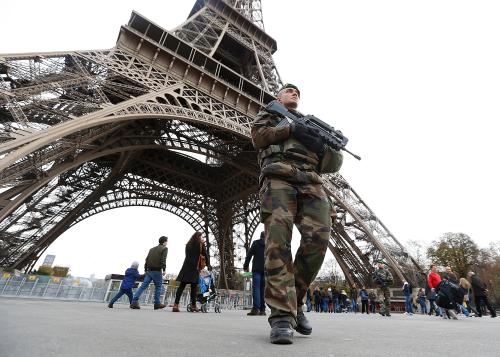In September of 2001, with lower Manhattan still freshly scarred and hued with ash, President Bush took to Congress to deliver the most consequential speech of his presidency. The United States was now at war, he announced, and while al-Qaida would be the initial target, it would not be the only one. Instead, President Bush vowed, the war “will not end until every terrorist group of global reach has been found, stopped and defeated.”
Sixteen years later, that end is nowhere in sight. The United States has spent at least $1.5 trillion in the war on terror, and lost nearly 7,000 soldiers and Marines. Yet al-Qaida is still very much with us, as its former offshoot, the Islamic State. Indeed, if anything the global reach of such groups has grown: This summer alone, the group has inspired or carried out multiple attacks in Europe, and captured an entire city in the Philippines.
Worse, three recent trends may accelerate that growth.
The first is technological. Although President Trump once described the Islamic State as medieval, it is anything but. Just as al-Qaida mastered cable news and satellite television, the Islamic State has thoroughly mastered digital media-and expertly repackaged jihadism for the smartphone era.
The group’s digital savvy has long since paid dividends. By saturating social media with its exploits and messaging—particularly its viral-ready videos and graphics—the group quickly outflanked its rivals to become the preferred “brand” of choice for jihadi facilitators around the globe. Thankfully many of its channels are now shut down, but not all. As Twitter and Facebook have become more aggressive in monitoring their platforms, some Islamic State supporters have simply switched over to Google Plus.
Yet the smartphone hasn’t just helped with recruitment. It has also dramatically improved the ability of jihadi networks to coordinate attacks. As Rukmini Callimachi, Bridget Moreng, and others have noted, the Islamic State has now begun to direct attacks from afar, occasionally even in real time. Key to this is encryption. Although strong public key cryptography has been around for a while, the iPhone and Android app stores have abstracted away the complexity involved with storing and managing keys. As a result, anyone capable of downloading WhatsApp or Telegram now has access to strong cryptography—which means that the Islamic State can now plot its attacks with greater confidence that the United States and its allies aren’t intercepting their actual messages.
Meanwhile, the second trend is tactical. Ironically, even as the Islamic State has adopted high-tech communications, many of its attacks are now decidedly low-tech affairs. As recent cells in Australia and Spain discovered, complex attacks may have a greater payoff, but they also have a greater likelihood of going wrong or being discovered. By contrast, simple attacks with knives or cars are far harder to interdict and disrupt—yet can be just as devastating. As Nice and even Barcelona demonstrated, the speeding van can be no less destructive than the spectacular explosion, yet requires far less training. Further, as Nathaniel Barr has pointed out, low-tech plots also enjoy the added benefit of placing added strain on intelligence services and law enforcement, which can no longer afford to triage suspects based on training and capability.
Finally, the last trend concerns returning foreign fighters. Lured in part by the Islamic State’s digital savvy, up to 40,000 individuals from around the world traveled to Syria to take part in the fight against Assad. Now that the tide has turned, particularly for the Islamic State, many fighters have packed up and gone home. Some of them were disillusioned along the way, but by no means all. As my Brookings colleague Dan Byman has explained, these fighters now pose a significant challenge. For one, they carry with them their contacts with Islamic State (or even al-Qaida) handlers in Syria, and can serve as ready conduits for further remote-controlled attacks. For another, as Thomas Hegghammer has shown, domestic attacks carried out by veterans of prior jihadi campaigns are far more effective and lethal than those without such veterans. Yet with police and law enforcement stretched thin by the prospect of further low-level attacks, these fighters will have greater room to maneuver.
Each of these trends is worrisome. But collectively they paint a frightening future for terrorism in the West. To avoid that future, D.C. and Silicon Valley will need to collaborate more closely on regulating the social web; cities will need to harden open spaces against vehicle attacks; and greater resources will have to be given to identifying and reintegrating returning fighters from Syria.
The smartphone era has brought unprecedented wealth and connectivity. We’ll need to manage it wisely, though, if we want it to bring less violence and more peace, too.
The Brookings Institution is committed to quality, independence, and impact.
We are supported by a diverse array of funders. In line with our values and policies, each Brookings publication represents the sole views of its author(s).








Commentary
Terrorism in the smartphone era, 16 years after 9/11
September 11, 2017